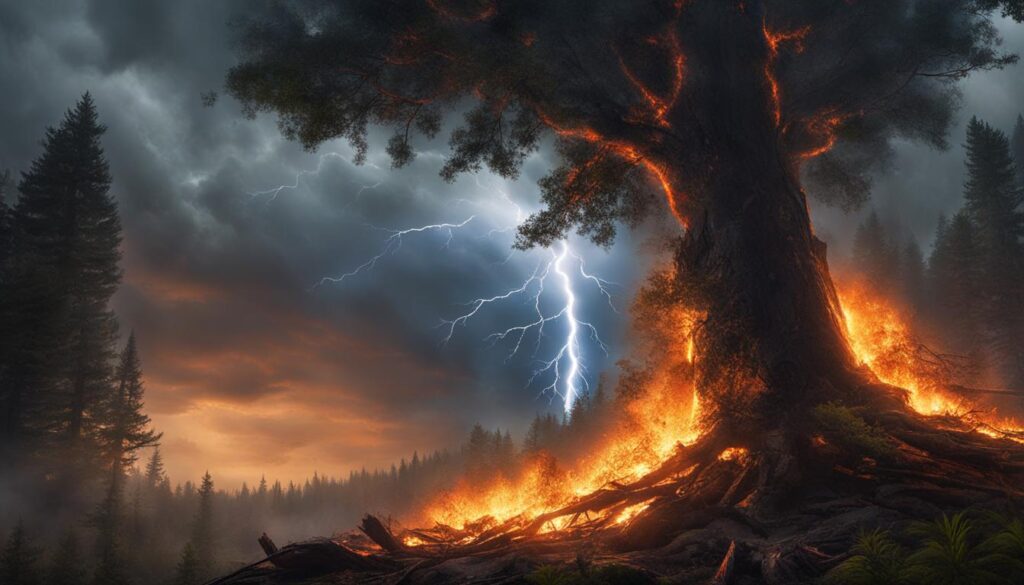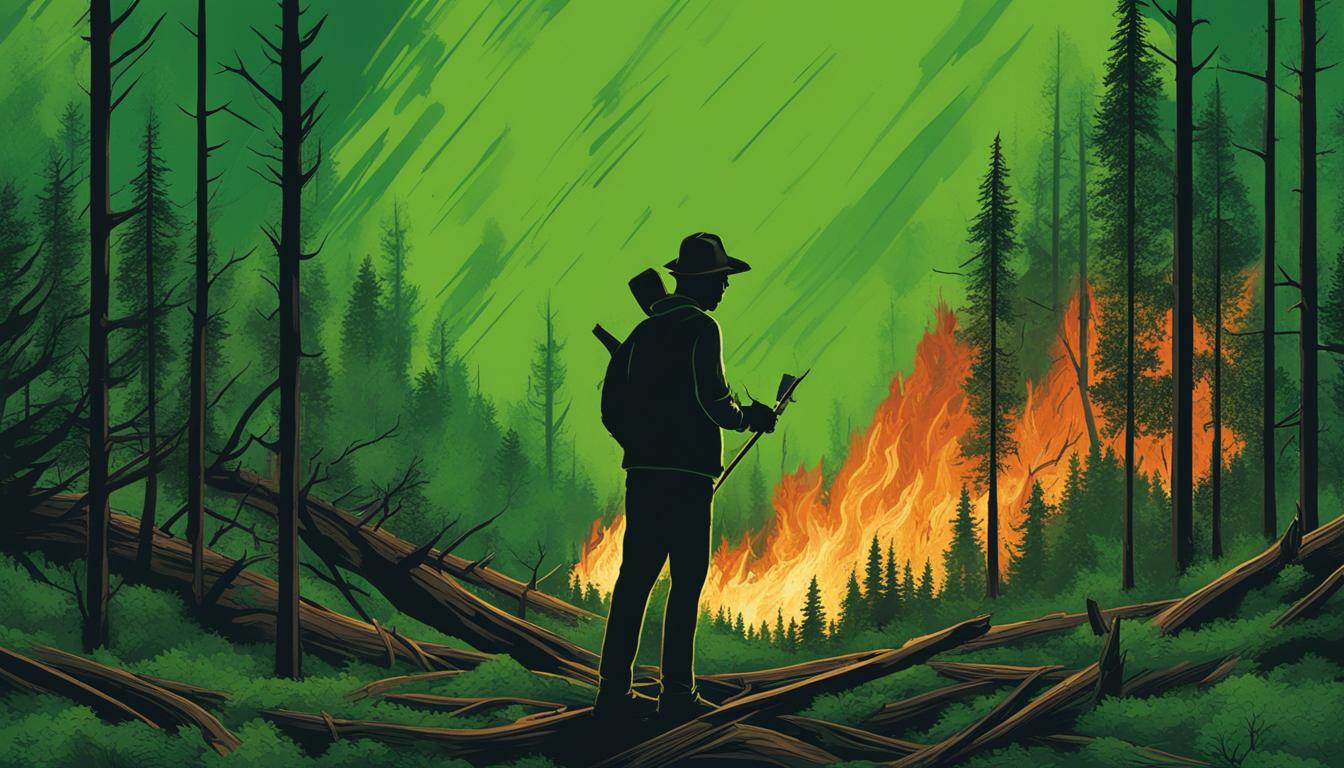Wildfires are a significant threat to forests and communities, causing destruction and loss of property and life. Understanding the causes of wildfires is essential in developing effective prevention and mitigation strategies. In this article, we will explore the difference between two main causes of wildfires: arson and lightning.
Arson refers to intentionally setting fires, whether for malicious purposes or as a result of negligence. On the other hand, lightning is a natural phenomenon that can ignite fires when it strikes the ground or vegetation. Both arson and lightning-induced wildfires have distinct characteristics and impacts on the environment and human communities.
Key Takeaways:
- Wildfires can be caused by human activities such as arson and natural occurrences like lightning strikes.
- Understanding the differences between arson and lightning-induced wildfires is crucial in developing prevention strategies.
- Arson is the deliberate act of setting fires, while lightning is a natural phenomenon that can ignite fires.
- Human-caused wildfires account for the majority of fire incidents in the United States.
- Prevention measures and responsible behavior can help mitigate the risk of human-caused wildfires.
Human-Caused Wildfires: Impact on Forests and Communities
Human-caused wildfires have a significant impact on forests and communities. These fires can result in the loss of natural habitats, destruction of vegetation, and displacement of wildlife. The consequences of these wildfires can be devastating, not only for the environment but also for human lives and property.
Fire prevention and wildfire prevention strategies are crucial in mitigating the risk of human-caused wildfires. Public education plays a vital role in raising awareness about fire safety practices and responsible behavior. By promoting the importance of extinguishing campfires, properly disposing of cigarette butts, and adhering to burning regulations, communities can minimize the occurrence of wildfires.
“It is essential for individuals to understand the potential consequences of their actions. One small spark can ignite a massive wildfire that can burn for days, destroy homes, and harm the ecosystem. Fire prevention is a shared responsibility, and everyone must play their part in protecting our forests and communities.” – Fire Safety Expert
Fire Safety Practices to Prevent Human-Caused Wildfires:
- Always fully extinguish campfires and never leave them unattended.
- Properly dispose of cigarettes in designated containers to avoid accidental ignitions.
- Follow local regulations regarding debris burning and never burn on windy days.
- Regularly maintain and inspect equipment to prevent malfunctions that may lead to fires.
Enforcement and Consequences:
Strict enforcement of fire safety regulations is essential to prevent human-caused wildfires. Law enforcement agencies, park rangers, and fire officials play a crucial role in monitoring and enforcing fire safety practices. Those who intentionally start wildfires through arson or negligence can face severe penalties, including fines, imprisonment, and restitution for damages caused.
The Importance of Fire Safety Education:
Public education campaigns and initiatives are essential in promoting fire safety and preventing human-caused wildfires. By educating individuals about the risks and consequences associated with fire-related activities, communities can work together to create a safer environment for all. Schools, community organizations, and government agencies should collaborate to deliver comprehensive fire safety programs that empower individuals with the knowledge and skills necessary to prevent wildfires.
Lightning-Induced Wildfires: Impact on Forests and Communities
Lightning-induced wildfires have a significant impact on forests and communities. These fires can ignite in remote areas where vegetation is abundant and spread rapidly, threatening nearby communities and infrastructure. Unlike human-caused wildfires, lightning strikes cannot be prevented. However, measures can be taken to reduce the risk and impact of these fires.
Effective monitoring and early detection systems play a crucial role in identifying and responding promptly to lightning-induced ignitions. By detecting and locating fires as soon as possible, firefighters can maximize their efforts in containing and extinguishing the fires before they become uncontrollable.
In addition to early detection, proper fire management techniques are essential in mitigating the severity and spread of lightning-induced wildfires. This includes strategies such as creating fire breaks, clearing vegetation around structures, and implementing controlled burns. By creating buffer zones and removing potential fuel sources, the impact of these fires can be minimized.
Benefits of Lightning-Induced Fires
While lightning-induced wildfires pose a threat to forests and communities, it is important to note that these fires can also have ecological benefits. In certain ecosystems, natural fires help maintain biodiversity by clearing out old vegetation and promoting the growth of new plant species. They also play a role in nutrient cycling and the regeneration of certain tree species.
“Lightning-induced fires, when managed properly, can contribute to the natural balance and health of ecosystems.”
However, it is crucial to carefully evaluate each situation and determine the appropriate response based on the location and potential impacts of the fire. Fire management agencies, researchers, and stakeholders work together to assess the benefits and risks of allowing lightning-induced fires to burn or implementing suppression strategies to protect human lives and property.

| Impacts of Lightning-Induced Wildfires | Prevention and Management Strategies |
|---|---|
| 1. Threat to forests and vegetation | 1. Effective monitoring and early detection systems |
| 2. Rapid spread, threatening nearby communities | 2. Prompt response and containment efforts |
| 3. Damage to infrastructure | 3. Creation of fire breaks and buffer zones |
| 4. Ecological benefits in certain ecosystems | 4. Careful evaluation of each fire situation |
Evaluating Wildland Fires: Threats and Management Approaches
Evaluating wildland fires involves assessing the threats they pose to both people and property, as well as determining their location within different landscapes. This evaluation process is crucial for developing effective fire management strategies and minimizing the potential impact of wildfires. Fire management agencies and investigators play a significant role in understanding the causes of wildfires, implementing prevention strategies, and planning for the potential effects of wildfires on the environment and human communities.
Threat assessment is an essential component of evaluating wildland fires. It involves analyzing various factors such as weather conditions, fuel availability, and the proximity of human activities to determine the potential risk posed by a fire. By understanding these threats, fire management teams can allocate resources and prioritize their efforts to protect lives and property.
In some cases, allowing natural fires to burn can be a management approach. This is particularly true in large national parks and forests where fire plays a vital role in ecosystem dynamics. Natural fires can help maintain a healthy balance by reducing vegetation density and promoting the growth of certain plant species. Fire management agencies carefully monitor these fires to ensure they remain within acceptable parameters and do not pose a threat to human communities.
Proactive fire management strategies also include implementing preventive measures such as creating fire breaks, conducting controlled burns, and educating the public about fire safety. By reducing the availability of fuel and promoting responsible behavior, the risk of large and destructive wildfires can be minimized. Effective monitoring, early detection systems, and prompt response to ignition also contribute to effective fire management and containment.
| Threat Assessment factors | Description |
|---|---|
| Weather Conditions | Includes factors such as temperature, humidity, wind speed, and direction, which can influence fire behavior and spread. |
| Fuel Availability | Refers to the amount and type of vegetation present in an area, which can serve as fuel for a fire. |
| Human Activities | Includes the proximity of residential areas, infrastructure, and recreational activities, which can increase the risk of fire ignitions. |
| Topography | Refers to the physical features of the landscape, such as slopes and valleys, which can affect fire behavior and spread. |
Causes of Wildfires: Human vs Naturally Occurring
Wildfires can be caused by two main factors: human activities and natural occurrences. Human-caused wildfires are often the result of negligent or intentional actions, such as campfires left unattended, debris burning, or acts of arson. These fires can spread quickly and have severe consequences for forests and communities. On the other hand, naturally occurring wildfires are primarily caused by lightning strikes, which ignite vegetation in remote areas. Understanding the differences between these two types of wildfires is crucial for implementing effective prevention strategies and allocating resources for fire management.
Human-caused wildfires, also known as anthropogenic wildfires, are responsible for a significant proportion of wildland fires. These fires can occur due to various reasons, including carelessness, ignorance of fire safety measures, or deliberate acts of arson. According to data, nearly 85 percent of wildland fires in the United States are caused by humans. The impacts of human-caused wildfires are far-reaching, resulting in habitat loss, destruction of vegetation, and the displacement of wildlife. It is essential to promote fire prevention and educate the public about responsible behavior to reduce the occurrence and severity of these fires.
Naturally occurring wildfires, on the other hand, are primarily caused by lightning strikes. In areas prone to thunderstorms, lightning can ignite dry vegetation and start fires. These fires are influenced by weather conditions, including the presence of fuel, temperature, and humidity. While lightning-induced wildfires cannot be prevented, measures can be taken to reduce their risk and impact. This includes effective monitoring and early detection systems, prompt response to ignitions, and proper fire management techniques. Additionally, implementing wildfire prevention strategies such as creating fire breaks and clearing vegetation around structures can help mitigate the severity and spread of these fires.
The Differences Between Human-Caused and Naturally Occurring Wildfires
To better understand the causes of wildfires, let’s compare the characteristics of human-caused and naturally occurring fires:
| Human-Caused Wildfires | Naturally Occurring Wildfires |
|---|---|
| Result from human activities such as campfires, debris burning, and acts of arson | Primarily caused by lightning strikes |
| Can spread quickly and become large, destructive fires | Tend to ignite in remote areas with abundant vegetation |
| Can be prevented through fire safety measures and responsible behavior | Cannot be prevented but can be managed through effective fire management techniques |
| Account for the majority of wildland fires in the United States | Make up a smaller portion of wildland fires but can be significant in certain regions |
By understanding the causes and characteristics of wildfires, communities and authorities can work together to implement appropriate prevention and management strategies. Fire prevention measures, public education, and responsible behavior are crucial in reducing the frequency and severity of human-caused wildfires. Meanwhile, effective monitoring, early detection, and proper fire management techniques can help mitigate the impacts of naturally occurring wildfires. By addressing both human-caused and naturally occurring fire causes, we can protect our forests, wildlife, and communities from the devastating effects of wildfires.
Conclusion
The difference between wildfire causes, specifically arson versus lightning, plays a crucial role in developing effective fire prevention and mitigation strategies. Human-caused wildfires, which account for the majority of fire incidents in the United States, result from activities such as campfires, burning of debris, arson, and negligence. These fires can be prevented through the implementation of fire safety measures and responsible behavior.
On the other hand, lightning-induced wildfires, though less frequent, can have a significant impact, especially in remote areas with abundant vegetation. While lightning strikes cannot be prevented, measures can be taken to reduce the risk and impact of these fires. Effective monitoring and early detection systems, prompt response to ignitions, and proper fire management techniques are key in mitigating their severity and spread.
By understanding the causes and impacts of wildfires, communities and authorities can work together to protect forests, wildlife, and human lives. Implementing fire prevention measures, educating the public about fire safety, and having robust fire management systems are essential in reducing the frequency and severity of wildfires. Through these collective efforts, the risks posed by both human-caused and naturally occurring wildfires can be minimized, ensuring the safety of our environment and communities.
FAQ
What causes wildfires?
Wildfires can be caused by human activities such as campfires, burning of debris, arson, and negligence. They can also be naturally caused by lightning strikes.
How can human-caused wildfires impact forests and communities?
Human-caused wildfires can result in the loss of natural habitats, destruction of vegetation, and displacement of wildlife. They can also pose a threat to communities by spreading rapidly and causing property damage.
What can be done to prevent human-caused wildfires?
Fire prevention strategies such as public education, stricter regulations, and enforcement of fire safety practices can help reduce the occurrence and severity of human-caused wildfires. Responsible behavior, proper disposal of cigarettes, and safe campfire practices also play a crucial role in prevention.
How do lightning-induced wildfires impact forests and communities?
Lightning-induced wildfires can ignite in remote areas with abundant vegetation and spread rapidly, threatening nearby communities and infrastructure. These fires can result in the loss of habitat, destruction of vegetation, and displacement of wildlife.
Can lightning strikes be prevented?
Lightning strikes cannot be prevented, but efforts can be made to reduce the risk and impact of lightning-induced wildfires. This includes effective monitoring and early detection systems, prompt response to ignitions, and proper fire management techniques.
What are the different causes of wildfires?
Wildfires can be categorized into human-caused and naturally occurring. Human-caused wildfires are triggered by activities such as campfires, burning of debris, arson, and negligence. Naturally occurring wildfires are primarily caused by lightning strikes in remote areas.
 Skip to main content
Skip to main content


